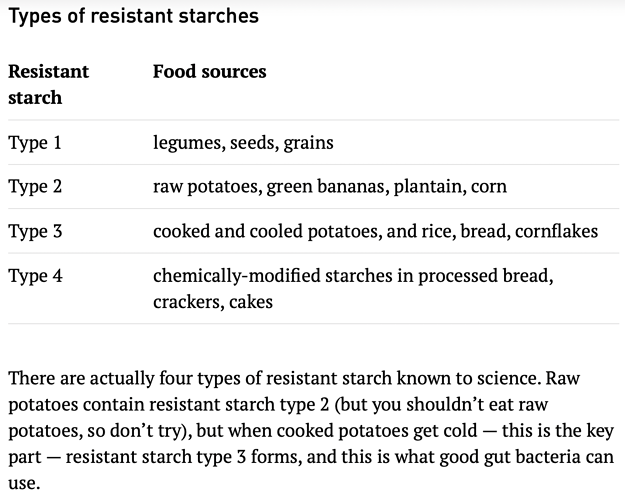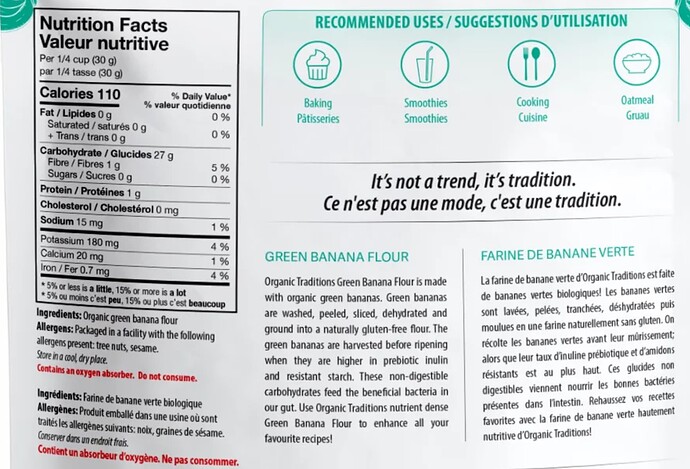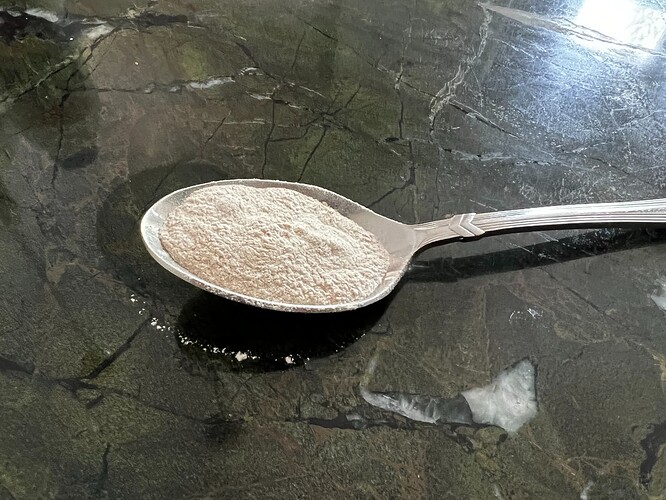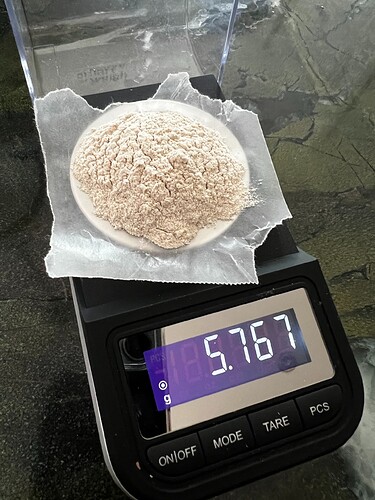My favorite (and super easy and delicious) resistant starch is cooked and cooled potatoes. Think potato salad or cold mashed potatoes. Yum! I found a website a couple of years ago that had lots of great info about resistant starch. If I can find it again I’ll post a link, but one of the things I remember is that there are different kinds, like R1 and R2 (I think) and also a variety of sources. Also good to use more than one source, as different beneficial gut bacteria benefit from different ones.
Here is another related article:
and
and
The first article says:
It’s important to not heat the potato starch. Instead, prepare the meal and then add the potato starch once the dish has cooled.
I see some news items saying the potato starch should be raw, others say just cold (after cooking). I wonder what the difference in terms of resistant starch levels between the two approaches is? Anyone know?
This is not the original site I was talking about, but it’s a good intro.
https://www.bulletproof.com/diet/bulletproof-diet/resistant-starch/
Raw potato starch is RS2. Cooked and cooled starch, which is regular starch transformed into resistant starch by the process of cooking and cooling, is RS3 or retrograded starch. RS3 can be found in a variety of cooked and cooled starchy foods, including potato.
I saw this table, but do you know which one of the starch types, from a benefit perspective which is best? (per the cancer study above, or elsewhere - it sounds like you’ve done some research on this topic already)
If we’re buying the powdered form of either raw potatoes, green bananas or plantains - I guess we’re good from the cancer perspective (the micro bacteria issue is a separate target from discussion here).
I would agree with aussimi that it’s probably a good idea to diversify and get a variety as different bacteria probably eat different resistant starches (and/or fibers).
By the way, if you buy the powdered form, note that potato flour is different from potato starch. Potato flour is made from whole potato; potato starch is just starch. So potato flour is potato starch plus other stuff.
Resistant starch has many other benefits besides cancer prevention. But readers may find Bobs Milll potato starch a tad more palatable than green bananas.it’s part of my smoothie.
Many of these products state that 4 tablespoons equals 30 grams. If only half of that is the resistant starch, we’d have to take 8 tablespoons a day to get our 30 grams. Seems like a lot.
One serving of Bob’s Red Mill potato starch (1 tbsp) is 12g and 10g of it is carbs. Assume 60% of carbs is resistant starch yields 6g (10g x 60%). To get 30g, you need 5 tbsp, which is a lot.
But you can also get some from other foods that you eat, so you don’t have to get it all from this one source.
So what if we throw one green banana into the mix? Can we get the the potato down to 2 tablespoons?
It’s up to you, depending on what you like to eat…Don’t forget other foods that have resistant starch such as beans. I don’t know if green bananas taste good enough to eat.
Also keep in mind that resistant starch is like fiber and different people may be able to tolerate different amounts of fiber. Excess fiber may cause bloating and gas.
Per the full text of the resistant starch study in Lynch Syndrome patients:
“Daily interventions were 30 g of RS (1:1 blend of Novelose 240 and Novelose 330) or placebo [waxy starch (Amioca)].”
NOVELOSE 240 Resistant Starch (foodingredientsonline.com)
NOVELOSE® 330 | Ingredion | Ingredients Network
Sounds like the study participants actually got 30g total of a 50% mix of novelose 240 and novelose 330, each of which only has 30% and 40% of resistant starch, so the actual dose of RS was more like 10 grams daily, which makes a lot more sense. 30g of pure RS would likely cause some GI issues (bloating, gas, diarrhea) and would be a lot of powder to consume (total of about 100grams per day of the novelose 240/330 mixture, which seems unfeasible).
I put 2 tablespoons of green banana flour in my smoothie every morning, which should provide just about 10g of resistant starch (probably more, since I make them heaping tablespoons):
Amazon.com : Let’s Do Organic Green Banana Flour, 14 Ounce (BWA25059) : Grocery & Gourmet Food
Alternatively, buy the greenest bananas you can find in the grocery store, peel them immediately when you get home (I use non-latex medical gloves because the green bananas have a lot of sticky sap, and I make one long vertical slice down the banana to take the peel off, because the peels are extremely thick and tough), chop and let sit on a tray/pan in the freezer until frozen (otherwise the pieces stick together when they freeze), then once frozen dump them into large freezer bag and use in smoothies. This takes some effort, but it is a LOT cheaper than buying green banana flour. I also add some extra stevia powder to the smoothie to offset the “green banana” flavor and its relative lack of sweetness.
Thanks for the deeper dive into this Davin. That makes much more sense and is actually doable.
This is what I recently purchased. I called manufacturer, they didn’t have resistant starch data sheet readily available…“it’s not a regulatory requirement”! He has to reach out to the supplier in SE Asia.
He guesstimated 50% of the powder is RS.
I poured out a typical full tablespoon and weighed it out. It’s only about 6g. So I’m only taking about 3g/day RS via this source. I really only added it back for SCFA. Taking 10 tablespoons would likely cause me “some discomfort”
I wouldn’t touch “raw potato flour” especially if they mix in some green ones and eating high amounts. Solanine and some other stuff. Cooking alters the resistant starch into a different form AFAIK.
Okinawans use purple sweet potato. No solanine issues and different resistant starch ![]()
Frankly, I’ll probably skip on this one.
I received notice of a new Joe Cohen podcast on resistant starch. He has developed a no banana type that can be purchased on Amazon.
Not assessed for accuracy but some of these percentages seem correct.
GPT-4o
Here’s a list of some common foods containing resistant starch, arranged in descending order of their resistant starch content. The values can vary depending on preparation methods and specific varieties, but these provide a general idea:
- Raw Potato Starch: Up to 75% resistant starch.
- Green Banana Flour: Approximately 55-60% resistant starch.
- Cooked and Cooled Legumes (e.g., lentils, chickpeas): 4-5% resistant starch.
- Cooked and Cooled Pasta: Approximately 3-4% resistant starch.
- Cooked and Cooled Potatoes: Approximately 3-4% resistant starch.
- Cooked and Cooled Rice: Approximately 2-5% resistant starch.
- Oats (especially if soaked overnight): Approximately 1-2% resistant starch.
- Unripe Bananas: Approximately 4-5% resistant starch (can vary with ripeness).
- High-Maize Corn Starch: Up to 60% resistant starch (specific to certain high-amylose maize).
These values are approximations and can vary based on factors like processing, specific type, and preparation methods. Cooking and then cooling starches such as pasta, potatoes, and rice increases their resistant starch content through a process called retrogradation.



